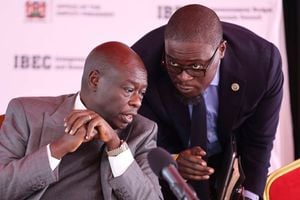Crossing Likoni channel in a flash: Inside Sh1.7bn floating bridge design

The Likoni crossing channel in Mombasa.
What you need to know:
- The project that will cost Sh1.7 billion will end the congestion witnessed at the channel used by more than 300,000 people daily.
- China Road and Bridge Corporation (CRBC) is the main contractor and is set to complete the work by the end of this year.
It will take only seven minutes to cross the Likoni channel in Mombasa once the floating bridge is complete.
This is the new reality awaiting residents once the 700 metres long Likoni Floating Bridge, which is currently under construction is complete. The bridge runs from Liwatoni in Mombasa Island to Ras Bofu (Peleleza) in Likoni.

China Road and Bridge Corporation is expected to complete the work this year.
The project that will cost Sh1.7 billion will end the congestion witnessed at the channel used by more than 300,000 people daily. China Road and Bridge Corporation (CRBC) is the main contractor and is set to complete the work by the end of this year.
According to design details obtained by the Saturday Nation, the floating bridge will comprise a 715-metre long floating section, and 54-metre long approaches on either side of the floating span.
Initial documents show that the bridge was to be built near the Mama Ngina Waterfront for easy access by pedestrians.
Collision of vessels
This was, however, not viable because of risks experts involved in the project pointed out.
The dangers included collision of vessels because of congested water while the turning place of the channel posed a high possibility of a commercial ship hitting the floating bridge.
Other risks included a seabed cable in the vicinity and strong waves, which could swing the bridge.
The risks forced the site to be changed to Liwatoni which was termed as safe, but raised the cost of the bridge from Sh1.5 billion to Sh1.7 billion.
This further forced the acquisition of 0.85 ha from Simba Colt Motors Limited owned by billionaire Adil Popat and two others, 0.3 ha and 0.2 ha owned by Koifan Developers Limited, which are on the Liwatoni side, allowing the project to start.
Following the change of plan, the Saturday Nation has learnt that the infrastructure in Liwatoni will be improved and a matatu terminus put up at Coca Cola, which is few metres from the bridge.
The works for the project will involve construction of pile foundations and a bailey type approach bridge with movable main steel bridge at the middle of the channel that allows ship movements.
Fishing boats
For big ships, the bridge will have a swing opening of a clear 150 metres width while for small fishing boats, there would be a bascule opening of five metres, the design shows.
The Nation has learnt that two Kenya Ports Authority (KPA) tag boats will be used to open and close the bridge in case there are ships entering or leaving the Mombasa port.
Kenya Ferry Services (KFS) managing director Bakari Gowa said once completed, the bridge will help deal with at least 40 per cent of pedestrian congestion at the Likoni channel.
“The project is one of those that we are looking forward too as it will help us deal with the congestion even if it is a smaller percentage of it,” said Mr Gowa, who added that already, another section of ferry users are using the Mtongwe channel whose operations resumed on September 1.
The bridge will be of advantage to residents of Bofu ward, which is directly opposite the Liwatoni side.
There are at least 18,000 registered voters in the ward. Salim Juma, a resident, said the bridge will help them avoid the “Likoni disaster”.
“With the bridge, one will walk to town in just some minutes and get back unlike using the channel which is chaotic. We are hopeful that the bridge will help,” he said.
The construction of the bridge is expected to stem spread of Covid-19 and other respiratry diseases associated with congestion.
Kenya National Highways Authority (KeNHA), which entered into an agreement with China Road and Bridge Construction (CRBC) for the construction of the project, said that the National Surveillance Systems had raised concerns on compliance of public health guidelines at Likoni ferry, hence the consideration for the building of the bridge.
“Despite commendable efforts by County Coordination Units and security personnel and the Kenya Ferry Services to streamline services, overcrowding at ferry has been rampant, with queues that exceed 1km at peak hours on either side,” states a brief by KeNHA.
Mombasa Senator Mohammed Faki, however, poked holes at the project asking whether it had been subjected to public participation.
Mr Faki claimed the Likoni channel is a dangerous spot, thus people who are going to use the bridge need to be fully aware of what they should expect.
Likoni Gate Bridge
“You should not subject us to a bridge that is going to endanger our lives, because we know the depth of this channel and how dangerous it is,” he said.
The floating bridge is different from the Likoni Gate Bridge, which will be constructed at a cost of Sh210 billion.
The government has so far secured a commitment of Sh46 billion from the Japanese government for the project, also known as the Likoni Gate Bridge.
The cable supported bridge will tower over the channel by 69 metres at the highest water level and will be 1.4 kilometres long.
Meanwhile, the construction of the Dongo Kundu bypass is ongoing.
Its construction is being done concurrently with the third phase, which is being done from Kwale side.
The Sh39 billion project will be completed in the next four years, according to plans by KeNHA.
The phase II and phase III of the project whose construction is expected to be complete by 2023 will cost Sh28 billion. The first phase, which was done at a cost of Sh11 billion is already in use.





